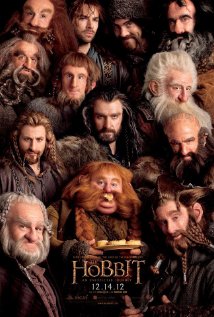Review: The Hobbit: An Unexpected Journey
 Nine years have now passed since the last entry in Peter Jackson's The Lord of the Rings trilogy, The Return of the King, was released. The series was so wildly successful it seemed obvious that J.R.R. Tolkien's prequel to the series, The Hobbit, would receive the Jackson treatment, but scheduling and rights issues among many other problems almost put an end to the production repeatedly.
Nine years have now passed since the last entry in Peter Jackson's The Lord of the Rings trilogy, The Return of the King, was released. The series was so wildly successful it seemed obvious that J.R.R. Tolkien's prequel to the series, The Hobbit, would receive the Jackson treatment, but scheduling and rights issues among many other problems almost put an end to the production repeatedly.
Now here we are with The Hobbit: An Unexpected Journey -- the first in a trilogy that brings to life the original tale, Tolkien's first book of Middle-earth, not only in 3D but in the new high frame-rate (HFR) 48 frames-per-second presentation.
Though only 5% of movie theaters will be outfitted and presenting in HFR, no review can fail to mention this gimmick. Some people view it as perfectly lifelike. Another camp sees it as the end of cinema. Based on my own experience watching the film, the technology has potential, but it practically will require more practice to perfect the art. Like an artist used to working in oils who suddenly finds himself using Photoshop, new skills are needed, and this feels like an experiment not quite perfected.
I won't go into specifics on the problems I saw with HFR. You can watch in either or both formats and decide for yourself. Unfortunately, there are other problems with The Hobbit: An Unexpected Journey that can't be solved as simply as choosing which theater to watch it in.
Foremost, the majority of the film suffers from an excess of campiness or silliness. The source novel is more light-hearted in tone than the trilogy, but time and again the line is crossed beyond light-hearted to feeling as if Jackson took a cue from George Lucas' handling of Episode I: The Phantom Menace and made a film for much younger audiences. There are some pacing issues, especially at the beginning, but the tone is the most negative factor.
The good news is that it's still a great film. And when the HFR shots work, they REALLY work (particularly the scene involving storm giants). If we didn't have expectations based on The Lord of the Rings trilogy, most people would have no complaints. The story is rich, because screenwriters Fran Walsh and Philippa Boyens drew from additional Tolkien material that will not be fully realized until the next movie in the new trilogy, still in production.
The casting is perfect, Howard Shore's score is phenomenal, and the setting is unmistakeably Middle-earth. More than that, it can be said the trilogy from Fellowship of the Ring to The Return of the King was soaking in the elven aesthetic. The Hobbit, however, is squarely focused on dwarves, giving us our first glance at a living dwarf city, background on their history, and a look at their social interactions. Fans of the series, especially fans of dwarves, will find this a satisfying, perhaps even phenomenal adventure.

